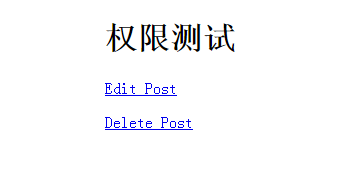您好,登錄后才能下訂單哦!
您好,登錄后才能下訂單哦!
這篇文章將為大家詳細講解有關如何在Laravel5.1框架中使用 ACL權限控制系統,文章內容質量較高,因此小編分享給大家做個參考,希望大家閱讀完這篇文章后對相關知識有一定的了解。
1. 創建角色與權限表
使用命令行創建角色與權限表:
php artisan make:migration create_permissions_and_roles --create=permissions
之后打開剛剛創建的文件,填入下面的代碼:
public function up()
{
Schema::create('roles', function (Blueprint $table) {
$table->increments('id');
$table->string('name');
$table->string('label');
$table->string('description')->nullable();
$table->timestamps();
});
Schema::create('permissions', function (Blueprint $table) {
$table->increments('id');
$table->string('name');
$table->string('label');
$table->string('description')->nullable();
$table->timestamps();
});
Schema::create('permission_role', function (Blueprint $table) {
$table->integer('permission_id')->unsigned();
$table->integer('role_id')->unsigned();
$table->foreign('permission_id')
->references('id')
->on('permissions')
->onDelete('cascade');
$table->foreign('role_id')
->references('id')
->on('roles')
->onDelete('cascade');
$table->primary(['permission_id', 'role_id']);
});
Schema::create('role_user', function (Blueprint $table) {
$table->integer('user_id')->unsigned();
$table->integer('role_id')->unsigned();
$table->foreign('role_id')
->references('id')
->on('roles')
->onDelete('cascade');
$table->foreign('user_id')
->references('id')
->on('users')
->onDelete('cascade');
$table->primary(['role_id', 'user_id']);
});
}
public function down()
{
Schema::drop('roles');
Schema::drop('permissions');
Schema::drop('permission_role');
Schema::drop('role_user');
}上面的代碼會創建角色表、權限表、角色與權限的中間表以及角色與用戶的中間表。
2. 創建模型
接下來使用命令行分別創建角色與權限模型:
php artisan make:model Permission php artisan make:model Role
然后分別打開Permission.php、Role.php 以及 User.php ,加入下面的代碼:
// Permissions.php
public function roles()
{
return $this->belongsToMany(Role::class);
}// Role.php
public function permissions()
{
return $this->belongsToMany(Permission::class);
}
//給角色添加權限
public function givePermissionTo($permission)
{
return $this->permissions()->save($permission);
}// User.php
public function roles()
{
return $this->belongsToMany(Role::class);
}
// 判斷用戶是否具有某個角色
public function hasRole($role)
{
if (is_string($role)) {
return $this->roles->contains('name', $role);
}
return !! $role->intersect($this->roles)->count();
}
// 判斷用戶是否具有某權限
public function hasPermission($permission)
{
return $this->hasRole($permission->roles);
}
// 給用戶分配角色
public function assignRole($role)
{
return $this->roles()->save(
Role::whereName($role)->firstOrFail()
);
}上面的代碼實現了給角色分配權限及給用戶分配角色,然后還提供了判斷用戶是否具有某角色及某權限的方法。
之后就給使用Laravel提供的Authorization來定義權限控制了,打開 /app/Providers/AuthServiceProvider.php 文件,在 boot() 中添加代碼:
public function boot(GateContract $gate)
{
parent::registerPolicies($gate);
$permissions = \App\Permission::with('roles')->get();
foreach ($permissions as $permission) {
$gate->define($permission->name, function($user) use ($permission) {
return $user->hasPermission($permission);
});
}
}通過上面的方法就定義好了各個權限。下面就該填充數據了。
3. 填充數據
為方便起見,這里使用 tinker 命令行工具來添加幾條測試數據:
php artisan tinker
之后進入命令行,依次輸入下列命令:
// 改變命名空間位置,避免下面每次都要輸入 App namespace App // 創建權限 $permission_edit = new Permission $permission_edit->name = 'edit-post' $permission_edit->label = 'Can edit post' $permission_edit->save() $permission_delete = new Permission $permission_delete->name = 'delete-post' $permission_delete->label = 'Can delete post' $permission_delete->save() // 創建角色 $role_editor = new Role $role_editor->name = 'editor'; $role_editor->label = 'The editor of the site'; $role_editor->save() $role_editor->givePermissionTo($permission_edit) $role_admin = new Role $role_admin->name = 'admin'; $role_admin->label = 'The admin of the site'; $role_admin->save() // 給角色分配權限 $role_admin->givePermissionTo($permission_edit) $role_admin->givePermissionTo($permission_delete) // 創建用戶 $editor = factory(User::class)->create() // 給用戶分配角色 $editor->assignRole($role_editor->name) $admin = factory(User::class)->create() $admin->assignRole($role_admin->name)
上面我們創建了兩個權限:edit-post 和 delete-post,然后創建了 editor 和 admin 兩個角色,editor 角色擁有 edit-post 的權限,而 admin 兩個權限都有。之后生成了兩個用戶,分別給他們分配了 editor 和 admin 的角色,即:ID 1 用戶擁有 editor 角色,因此只有 edit-post 權限,而 ID 2 用戶擁有 admin 角色,因此具有 edit-post 和 delete-post 權限。下面我們來驗證下是否正確。
打開 routes.php 文件:
Route::get('/', function () {
$user = Auth::loginUsingId(1);
return view('welcome');
})上面我們先驗證 ID 1 用戶的權限,然后修改 /resources/views/welcome.blade.php 文件:
<!DOCTYPE html>
<html>
<head>
<title>Laravel</title>
</head>
<body>
<h2>權限測試</h2>
<p>
@can('edit-post')
<a href="#" rel="external nofollow" rel="external nofollow" >Edit Post</a>
@endcan
</p>
<p>
@can('delete-post')
<a href="#" rel="external nofollow" rel="external nofollow" >Delete Post</a>
@endcan
</p>
</body>
</html>在視圖中我們通過 Laravel 提供的 @can 方法來判斷用戶是否具有某權限。
打開瀏覽器,訪問上面定義的路由,可以看到視圖中只出現了 Edit Post 鏈接。之后我們修改路由中用戶ID為 2 ,然后再次刷新瀏覽器,可以看到,這次同時出現了 Edit Post 和 Delete Post 兩個鏈接,說明我們定義的權限控制起作用了。

關于如何在Laravel5.1框架中使用 ACL權限控制系統就分享到這里了,希望以上內容可以對大家有一定的幫助,可以學到更多知識。如果覺得文章不錯,可以把它分享出去讓更多的人看到。
免責聲明:本站發布的內容(圖片、視頻和文字)以原創、轉載和分享為主,文章觀點不代表本網站立場,如果涉及侵權請聯系站長郵箱:is@yisu.com進行舉報,并提供相關證據,一經查實,將立刻刪除涉嫌侵權內容。